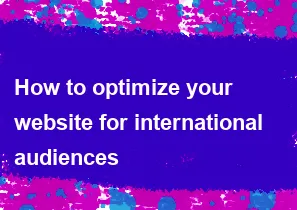How to optimize your website for international audiences

Optimizing your website for international audiences involves a combination of technical, content-related, and user experience considerations. Here are some key strategies to make your website more accessible and appealing to a global audience:
Multilingual Content:
- Translate your content into the languages spoken by your target audience. Use professional translators to ensure accuracy.
- Implement hreflang tags in your HTML to indicate language and regional targeting to search engines.
International SEO:
- Research and incorporate relevant keywords in multiple languages.
- Register your site with local search engines and directories.
- Obtain country-code top-level domains (ccTLDs) for specific countries if possible.
Responsive Design:
- Ensure your website is mobile-friendly and has a responsive design that adapts to various screen sizes and devices commonly used in different regions.
Cultural Sensitivity:
- Understand and respect cultural differences. Adapt your content and imagery to be culturally sensitive and appropriate for your target audience.
Local Hosting:
- Use Content Delivery Networks (CDNs) to host your website's content on servers located in different regions. This can improve loading times for users in various locations.
Currency and Pricing:
- Display prices in local currencies and enable users to switch between different currencies easily.
- Clearly communicate any international shipping costs or taxes.
Time Zone Considerations:
- Display dates and times in a format that is familiar to your international audience. Implement features that allow users to see time-sensitive information based on their local time zones.
Payment Options:
- Offer multiple payment options to accommodate different preferences and regional payment methods.
Compliance with Regulations:
- Be aware of and comply with international data protection and privacy regulations (e.g., GDPR in Europe) to build trust with your global audience.
Localized Customer Support:
- Provide customer support in multiple languages.
- Clearly display contact information, including regional phone numbers and email addresses.
User-Friendly Navigation:
- Ensure your website's navigation is intuitive and easy to understand, regardless of language.
- Test your website with users from different cultural backgrounds to identify any usability issues.
Social Media Integration:
- Use social media platforms to engage with your international audience.
- Share content that is relevant to specific regions and cultures.
Performance Optimization:
- Optimize website speed by compressing images, leveraging browser caching, and minimizing HTTP requests to enhance the user experience globally.
Legal Considerations:
- Review and update terms and conditions, privacy policies, and other legal documents to comply with international laws and regulations.
Regularly monitor your website's performance, user feedback, and analytics to make continuous improvements based on the evolving needs of your international audience.
-
Popular Post
- How to optimize for Google's About This Result feature for local businesses
- How to implement multi-language support in an Express.js application
- How to handle and optimize for changes in mobile search behavior
- How to handle CORS in a Node.js application
- How to use Vue.js with a UI framework (e.g., Vuetify, Element UI)
- How to configure Laravel Telescope for monitoring and profiling API requests
- How to create a command-line tool using the Commander.js library in Node.js
- How to implement code splitting in a React.js application
- How to use the AWS SDK for Node.js to interact with various AWS services
- How to use the Node.js Stream API for efficient data processing
- How to implement a cookie parser middleware in Node.js
- How to implement WebSockets for real-time communication in React
-
Latest Post
- How to implement a dynamic form with dynamic field styling based on user input in Next.js
- How to create a custom hook for handling user interactions with the browser's device motion in Next.js
- How to create a custom hook for handling user interactions with the browser's battery status in Next.js
- How to implement a dynamic form with dynamic field visibility based on user input in Next.js
- How to implement a dynamic form with real-time collaboration features in Next.js
- How to create a custom hook for handling user interactions with the browser's media devices in Next.js
- How to use the useSWRInfinite hook for paginating data with a custom loading indicator in Next.js
- How to create a custom hook for handling user interactions with the browser's network status in Next.js
- How to create a custom hook for handling user interactions with the browser's location in Next.js
- How to implement a dynamic form with multi-language support in Next.js
- How to create a custom hook for handling user interactions with the browser's ambient light sensor in Next.js
- How to use the useHover hook for creating interactive image zoom effects in Next.js